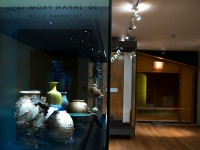Room 36 | Japan from 1850 gallery
Explore the major technical and creative developments in arts and crafts of Japan after 1850 and visit the Ashmolean's tea house.

‘The tea ceremony requires years of training and practice . . . yet the whole of this art, as to its detail, signifies no more than the making and serving of a cup of tea. The supremely important matter is that the act be performed in the most perfect, most polite, most graceful, most charming manner possible.’
(Lafcadio Hearn, Japan: An Attempt at Interpretation, 1904)
The preparation and drinking of tea in a formal ‘ceremony' has been practised in Japan since the 1400s. This is called chanoyu (‘hot water for tea'). In the Japanese tea ceremony participants withdraw from the stresses of daily life to the peaceful setting of a special tea room made of simple natural materials.
The tea master prepares and serves the tea using set movements: scooping powdered green tea into a tea bowl, ladling over hot water, mixing the tea with a bamboo whisk and then serving tea to each guest in turn.
Conversation is kept to a minimum throughout. After drinking, guests admire the tea utensils carefully selected by the tea master. Even the guests need to use set gestures and phrases.
Notice
Objects may have since been removed or replaced from a gallery. Click into an individual object record to confirm whether or not an object is currently on display. Our object location data is usually updated on a monthly basis, so contact the Jameel Study Centre if you are planning to visit the museum to see a particular Eastern Art object.
© 2013 University of Oxford - Ashmolean Museum
